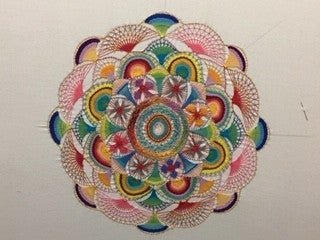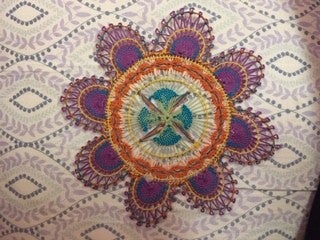Nirmala Waterhouse (Eugene) is a textile and embroidery artist who specializes in ñandutí, a traditional Paraguayan lace. Ñandutí means “spider web” in Guaraní, the indigenous language of Paraguay. Often displayed as wall hangings, altar pieces, or used as embellishment on festive dresses, ñandutí is a versatile artform. Waterhouse has showcased her work at the Whitaker market in Eugene, Oregon, often through live demonstrations of her ñandutí-making process.
Bio
Nirmala Waterhouse (Eugene) is a textile and embroidery artist who specializes in ñandutí, a traditional Paraguayan lace. Ñandutí means “spider web” in Guaraní, the indigenous language of Paraguay. Often displayed as wall hangings, altar pieces, or used as embellishment on festive dresses, ñandutí is a versatile artform. Waterhouse has showcased her work at the Whitaker market in Eugene, Oregon, often through live demonstrations of her ñandutí-making process. “When I do these presentations, I love it because people have never seen this before. They're just like, ‘what is that? I’ve never seen anything like this before!’ That's really fun to me, not only for people to see something they've never seen before, but also teach people about Paraguay and ñandutí,” Waterhouse explains.
From a young age, Waterhouse watched her grandmother sew and embroider children’s clothing, which her grandfather would later take into a nearby town to sell. Her grandmother’s embroidery business supported their family, with Waterhouse’s mother later taking up the artform. Ñandutí pieces were always displayed in their home, and Waterhouse recalls learning about the weaving process through carefully observing their construction. “It's in my almost like in my genetics to fit and embroider. It just feels like I’m really called to do it. When I started doing it, I didn't think anybody would care. I didn't think anybody would really be that interested. But I’m noticing that people really are interested. I feel like when we're doing something really sincerely and something that we’re really called to do, there will be a response.”
After her family moved from Paraguay to Panama, then from California to Florida, Waterhouse eventually settled in Oregon. For over ten years, Waterhouse created embroidery pieces, but two years ago she decided to embrace her lineage and began weaving ñandutí on a hand-built, custom frame.
The process of making ñandutí involves cloth, embroidery thread, a tapioca flour paste, and some sort of frame. First, you cut a square of cloth and fasten it to the frame. Then Waterhouse says she uses a compass and a ruler to sketch out her design. Then she begins embroidering what will the background of the final product. Once she completes the background, she begins the weaving process. After she weaves the colorful threads into the background and forms the desired pattern, Waterhouse covers the pattern with a homemade tapioca flour paste. This starchy paste stiffens and strengthens the thread, giving it texture and form. When the paste has fully dried, she then cuts the woven pattern from the cloth square, revealing a freestanding ñandutí piece.
On the process of making ñandutí, Waterhouse says, “[w]hen I'm doing it, it just feels like the right thing to do. I feel like I'm doing something that, even though I'm not saving the world by making these, I feel like it's important to create beauty in the world. I think it's important to carry our cultures and our practices from our ancestors and because they have deep meaning and deep beauty.”



